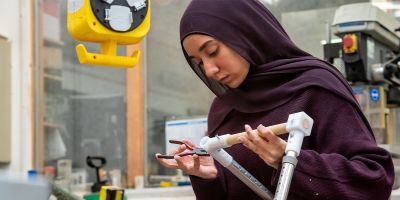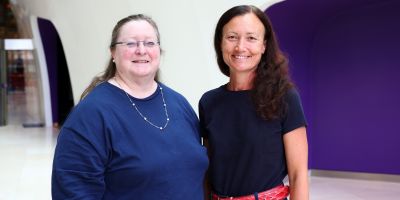Minister impressed by University’s quantum cascade laser

The minister for industry has visited the University of Leeds this week to learn how developing terahertz frequency technology has made the Faculty of Engineering one of the leading centres in Europe.
Anna Soubry MP, Minister for Small Business, Industry and Enterprise within the Department for Business, Innovation and Skills, toured an electronics laboratory to see first-hand how tiny lasers on a chip the size of a camera memory card have been developed.
Terahertz frequency technology is a scientific field opening up the uses of the far-infrared region of the electromagnetic spectrum.
She met with Professor Giles Davies, Pro-Dean for Research and Innovation, who explained the uses of the quantum cascade laser. It can be used in non-destructive testing in the pharmaceutical and other industries, in medical imaging, in the identification of materials of security relevance, and in the investigation of gases in the atmosphere. Part of this work is funded by the European Space Agency and could provide information on the causes of climate change.
The minister, on a fact-finding mission across the Yorkshire, also met with Professor Edmund Linfield, who works alongside Professor Davies on terahertz research. In 2014, the pair won the Faraday Medal from the Institute of Physics for their terahertz research, in recognition of an outstanding contribution to experimental physics.
Professor Davies explained how a significant proportion of his research has been funded by the European Union, which has also supported early career researchers across the University.
After learning about the cutting edge research carried out each day in the University’s laboratories, Anna Soubry described Leeds as a ‘brilliant place to study’, and a ‘first class university’. She said: “The thing that is striking is Leeds benefits from the support this country’s government gives, but it undoubtedly benefits from the support the EU provides as well. Some of that is research grants but it is also the free movement of British-born students to go and travel and study, and the free movement of other EU students to come to a great university like this and to enjoy all that goes with it.”
During the visit, Ms Soubry also met with the University’s Deputy Vice Chancellor Professor John Fisher, Director of Research and Innovation Development, Dr Ceri Williams and Dr Sarah Underwood, Director of the University’s Centre for Enterprise and Entrepreneurship. The group discussed the university’s wider role in the region and how it is forging links across business and industry.
Ms Soubry said: “It was good to have a conversation about how the University is working really closely with all the businesses in the greater Leeds area. That was very interesting: Your research is world leading and that research will have direct consequences and benefits for businesses here and in other parts of the country. Some of the other points about research projects involving capital spending was very interesting and I’ll take that away with me.”
She also highlighted the importance of collaborative work across Europe to create and deliver great research projects.
Speaking after the visit, Professor Davies, said: “We were pleased to host Anna Soubry, and to explain to her the impact our research can have. Terahertz frequency technology has great potential for non-destructive analysis of a number of products, directly benefiting industry in a number of fields.”
Terahertz frequencies span the gap in the electromagnetic spectrum between the millimetre/microwave electronic technologies used at lower frequencies, and the mid-infrared optic/opto-electronic techniques found at higher frequencies.
Further information:
Read more about research in the Faculty of Engineering.
Media information: Peter Le Riche, University of Leeds press office 0113 343 2049 | p.leriche@leeds.ac.uk




